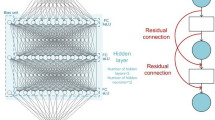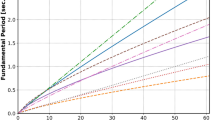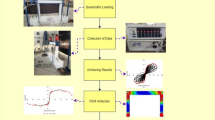Abstract
This study aims to develop machine learning (ML) models to predict the base shear of buckling restrained braced frames (BRBF). Four machine learning (ML) algorithms [random forest, artificial neural network (ANN), XGBoost, and Adaboost] were used to conduct this task. The training data were generated by conducting pushover analysis in OpenSeesPy. The BRBF model in OpenSeesPy considered both geometric and material nonlinearity. Six different configurations were used in this study. Each generated data point has unique frame properties (column, beam, BRB, boundary condition, leaning column and dead load, number of bays and stories, bay width, and story height). The learning and testing processes were conducted for each BRB configuration individually and for the combined data of all the configurations. Several statistical analyses were done to evaluate the prediction model and to study the importance of the BRBF properties based on their influence on the prediction. For that matter, the number of stories had the highest effect on the prediction values, and it shows that the higher the number of stories, the lower the maximum base shear that the frame can provide. The second most important feature is the core area of the BRB, where increasing the core area increases the base shear and vice versa. Furthermore, XGboost showed the best-predicted results, followed by Adaboost, Random Forest, and, Finally, artificial neural network (ANN). Finally, a graphical user interface based on the models was developed for the preliminary estimation of the base shear of buckling restrained braced frames.




















Similar content being viewed by others
References
ASCE. (2022). Minimum design loads and associated criteria for buildings and other structures. American Society of Civil Engineers.
Breiman, L. (2001). Random forests. Machine Learning, 45, 5–32.
Cao, X.-Y., Feng, D.-C., Wu, G., & Wang, Z. (2022). Experimental and theoretical investigations of the existing reinforced concrete frames retrofitted with the novel external SC-PBSPC BRBF sub-structures. Engineering Structures, 256, 113982.
Cao, X.-Y., Feng, D.-C., Wu, G., & Xu, J.-G. (2021). Probabilistic seismic performance assessment of RC frames retrofitted with external SC-PBSPC BRBF sub-structures. Journal of Earthquake Engineering, 26, 1–24.
Chen, T., & Guestrin, C. (2016). Xgboost: A scalable tree boosting system. Proceedings of the 22nd acm sigkdd international conference on knowledge discovery and data mining.
Fahnestock, L. A. (2006). Analytical and Large-Scale Experimental Studies of Earthquake-Resistant Buckling-Restrained Braced Frame Systems. Lehigh University.
Fahnestock, L. A., Sause, R., Ricles, J. M., & Lu, L.-W. (2003). Ductility demands on buckling-restrained braced frames under earthquake loading. Earthquake Engineering and Engineering Vibration, 2(2), 255–268.
Freddi, F., Ghosh, J., Kotoky, N., & Raghunandan, M. (2021). Device uncertainty propagation in low-ductility RC frames retrofitted with BRBs for seismic risk mitigation. Earthquake Engineering & Structural Dynamics, 50(9), 2488–2509.
Freund, Y., & Schapire, R. E. (1997). A decision-theoretic generalization of on-line learning and an application to boosting. Journal of Computer and System Sciences, 55(1), 119–139.
Gu, Q., Zona, A., Peng, Y., & Dall’Asta, A. (2014). Effect of buckling-restrained brace model parameters on seismic structural response. Journal of Constructional Steel Research, 98, 100–113.
Hoveidae, N., & Radpour, S. (2021). A novel all-steel buckling restrained brace for seismic drift mitigation of steel frames. Bulletin of Earthquake Engineering, 19, 1537–1567.
Hu, S., Zhu, S., Alam, M. S., & Wang, W. (2022). Machine learning-aided peak and residual displacement-based design method for enhancing seismic performance of steel moment-resisting frames by installing self-centering braces. Engineering Structures, 271, 114935.
Hung, D. V., Thang, N. T., & Dat, P. X. (2021). Probabilistic pushover analysis of reinforced concrete frame structures using dropout neural network. Journal of Science and Technology in Civil Engineering (STCE)-HUCE, 15(1), 30–40.
Kaveh, A., Bakhshpoori, T., & Hamze-Ziabari, S. M. (2018). GMDH-based prediction of shear strength of FRP-RC beams with and without stirrups. Computers and Concrete, an International Journal, 22(2), 197–207.
Kaveh, A., Eskandari, A., & Movasat, M. (2023). Buckling resistance prediction of high-strength steel columns using Metaheuristic-trained artificial neural networks. Structures, 56, 104853.
Kaveh, A., Gholipour, Y., & Rahami, H. (2008). Optimal design of transmission towers using genetic algorithm and neural networks. International Journal of Space Structures, 23(1), 1–19.
Kaveh, A., & Iranmanesh, A. (1998). Comparative study of backpropagation and improved counterpropagation neural nets in structural analysis and optimization. International Journal of Space Structures, 13(4), 177–185.
Kaveh, A., & Khavaninzadeh, N. (2023). Efficient training of two ANNs using four meta-heuristic algorithms for predicting the FRP strength. Structures, 52, 256–272.
Kersting, R. A., Fahnestock, L. A., & López, W. A. (2015). Seismic design of steel buckling-restrained braced frames. NIST GCR: 15–917.
Lundberg, S. M., & Lee, S.-I. (2017). A unified approach to interpreting model predictions. Advances in neural information processing systems 30
Málaga-Chuquitaype, C. (2022). Machine learning in structural design: an opinionated review. Frontiers in Built Environment. https://doi.org/10.3389/fbuil.2022.815717
McKenna, F., Scott, M. H., & Fenves, G. L. (2010). Nonlinear finite-element analysis software architecture using object composition. Journal of Computing in Civil Engineering, 24(1), 95–107.
Merritt, S., Uang, C.-M., & Benzoni, G. (2003). Subassemblage testing of Star Seismic buckling-restrained braces. Test report, University of California, San Diego.
Newell, J., Uang, C.-M., & Benzoni, G. (2006). Subassemblage testing of CoreBrace buckling-restrained braces (G Series).
Nguyen, H. D., Dao, N. D., & Shin, M. (2021). Prediction of seismic drift responses of planar steel moment frames using artificial neural network and extreme gradient boosting. Engineering Structures, 242, 112518.
Schapire, R. E. (1990). The strength of weak learnability. Machine Learning, 5, 197–227.
Speicher, M. S., & Harris, J. L., III. (2019). Assessment of First Generation Performance Based Seismic Design Methods for New Steel Buildings, vol. 4 Buckling-Restrained Braced Frames. National Institute of Standards and Technology.
Stefanini, L., Badini, L., Mochi, G., Predari, G., & Ferrante, A. (2022). Neural networks for the rapid seismic assessment of existing moment-frame RC buildings. International Journal of Disaster Risk Reduction, 67, 102677.
Thai, H.-T. (2022). Machine learning for structural engineering: A state-of-the-art review. Elsevier.
Tremblay, R., Degrange, G., Blouin, J. (1999). Seismic Rehabilitation of a Four-Story Building with a Stiffened Bracing System. Proceeding of the 8th Canadian Conference on Earthquake Engineering, vancouver.
Upadhyay, A., Pantelides, C. P., & Ibarra, L. (2019). Residual drift mitigation for bridges retrofitted with buckling restrained braces or self centering energy dissipation devices. Engineering Structures, 199, 109663.
Usami, T., Lu, Z., & Ge, H. (2005). A seismic upgrading method for steel arch bridges using buckling-restrained braces. Earthquake Engineering & Structural Dynamics, 34(4–5), 471–496.
Vadyala, S. R., Betgeri, S. N., Matthews, J. C., & Matthews, E. (2022). A review of physics-based machine learning in civil engineering. Results in Engineering, 13, 100316.
Wu, J.-R., & Di Sarno, L. (2023). A machine-learning method for deriving state-dependent fragility curves of existing steel moment frames with masonry infills. Engineering Structures, 276, 115345.
Zahra, F., Macedo, J., & Málaga-Chuquitaype, C. (2023). Hybrid data-driven hazard-consistent drift models for SMRF. Earthquake Engineering & Structural Dynamics, 52, 1112–1135.
Zaruma, S., & Fahnestock, L. A. (2018). Assessment of design parameters influencing seismic collapse performance of buckling-restrained braced frames. Soil Dynamics and EarthquaKe Engineering, 113, 35–46.
Funding
The authors declare that no funds, grants, or other support were received during the preparation of this manuscript.
Author information
Authors and Affiliations
Contributions
Humam Al-Ghabawi prepared the OpenSeesPy model and wrote everything related to OpenSeesPy (structural modeling) and contributed in writing the abstract, introduction, and the results. Mustafa. M. Khattab prepared Machine learning model and contributed in writing the abstract, introduction, and the results. Idrees A. Zahid prepared the user interface Bilal Al-Oubaidi wrote the Machine learning algorithms section.
Corresponding author
Ethics declarations
Conflict of interest
The authors have no relevant financial or non-financial interests to disclose.
Additional information
Publisher's Note
Springer Nature remains neutral with regard to jurisdictional claims in published maps and institutional affiliations.
Rights and permissions
Springer Nature or its licensor (e.g. a society or other partner) holds exclusive rights to this article under a publishing agreement with the author(s) or other rightsholder(s); author self-archiving of the accepted manuscript version of this article is solely governed by the terms of such publishing agreement and applicable law.
About this article
Cite this article
Al-Ghabawi, H.H.M., Khattab, M.M., Zahid, I.A. et al. The prediction of the ultimate base shear of BRB frames under push-over using ensemble methods and artificial neural networks. Asian J Civ Eng 25, 1467–1485 (2024). https://doi.org/10.1007/s42107-023-00855-3
Received:
Accepted:
Published:
Issue Date:
DOI: https://doi.org/10.1007/s42107-023-00855-3




